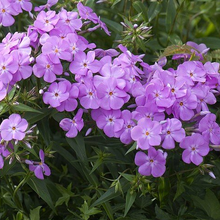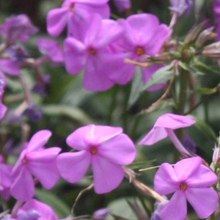Phlox glaberrima ‘Morris Berd’ is a clump forming phlox with glossy mildew resistant foliage and upright stems topped by fragrant lavender pink flowers. Bred for exceptional disease resistance and vigor, this cultivar fills the bloom gap between spring and high summer. Its sturdy stems and floriferous nature make it an excellent cut flower option for naturalistic or cottage gardens.
Height & Spread: 24 - 30 in x 18 - 24 in
Bloom Time: Early to midsummer
Light Requirements: Full sun to part shade
Soil Preference: Moist, fertile, well drained soil
Watering Needs: Moderate; avoid prolonged drought for best bloom
Deer Resistance: Moderately deer resistant
Native Status
This selection is derived from the native Phlox glaberrima, which occurs in moist meadows and woodland openings in the southeastern United States.
WILDLIFE & INSECTS
Butterflies
- Attracts swallowtails, fritillaries, and skippers such as Great Spangled Fritillary and Peck’s Skipper with its nectar rich flowers.
Bees
- Visited by long tongued native bees, bumblebees, and honeybees during peak bloom.
Moths
- Evening flowering fragrance draws sphinx moths such as Snowberry Clearwing and Hummingbird Clearwing.
Birds
- Seed heads may be foraged by finches and other small songbirds late in the season.
Spacing & Landscape Use
Spacing Recommendations
- Space 18 - 24 in apart to allow for full, upright clumps and air circulation between plants.
Landscape Placement
- Best for mixed borders, wildflower meadows, or as a showy midlayer in native pollinator gardens. Effective planted in drifts or among grasses and structural perennials.
Companion Plants
- Eryngium yuccifolium (Rattlesnake Master) - Offers architectural stems and silver green foliage that complements phlox’s upright form.
- Rudbeckia fulgida (Black Eyed Susan) - Produces sunny yellow daisies that bloom concurrently and echo the wildflower palette.
- Monarda bradburiana (Eastern Beebalm) - Adds aromatic foliage and earlier lavender pink flowers that blend well with phlox’s tones.
- Pycnanthemum muticum (Blunt Mountain Mint) - Provides silvery bracts and strong pollinator appeal in midsummer.
- Liatris spicata (Dense Blazing Star) - Offers spiky vertical contrast and late season blooms that extend garden interest.



